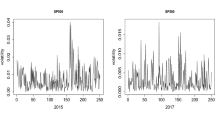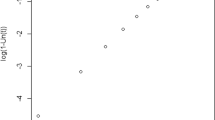Abstract
We discuss the relationship between the marginal tail risk probability and the innovation’s tail risk probability for some stationary financial time series models. We first give the main results on the tail behavior of a class of infinite weighted sums of random variables with heavy-tailed probabilities. And then, the main results are applied to three important types of time series models: infinite order moving averages, the simple bilinear time series and the solutions of stochastic difference equations. The explicit formulas are given to describe how the marginal tail probabilities come from the innovation’s tail probabilities for these time series. Our results can be applied to the tail estimation of time series and are useful for risk analysis in finance.
Similar content being viewed by others
References
Mandelbrot, B., The variation of certain speculative prices, Journal of Business, 1963, 36: 394–419.
Mandelbrot, B., New methods in statistical economics, Journal of Political Economy, 1963, 71: 421–440.
Fama, E., The behavior of stock market prices, J. Business, 1965, 38: 34–105.
Adler, R. J., Feldaman, R., Taqqu, M. (eds.), A User’s Guide to Heavy Tails: Statistical Techniques for Analyzing Heavy Tailed Distribution and Processes, Boston: Birkhauser, 1997.
Resnick, S., Heavy tail modeling and teletraffic data, Ann. Statist., 1997, 25: 1805–1869.
Barndorff-Nielsen, O. E., Shephard, N., Non-Gaussian Ornstein-Uhlenbeck-based models and some of their uses in financial economics, J. R. Statist. Soc. B, 2001, Vol. 63, Part 2: 167–241.
Cline, D., Estimation and linear prediction for regression, autoregression and ARMA with infinite variance data, Ph. D. dissertation, Dept. Statistics, Colorado State Univ., 1983.
Resnick, S., Extreme Values, Regular Variation, and Point Processes, New York: Springer, 1987.
Davis, R., Resnick, S., Limit theory for bilinear processes with heavy tailed noise, Ann. Appl. Prob., 1996, 6: 1191–1210.
De Haan, L., Resnick, S. I., Rootzen, H. et al., Extremal behavior of solutions to a stochastic difference equation with applications to ARCH process, Stochastic Process Appl., 1989, 32: 213–224.
Embrechts, P., Kluppelberg, C., Mikosch, T., Modelling Extremal Events for Insurance and Finance, Berlin: Springer-Verlag, 1997.
Pan, J. Z., Tail dependence of random variables from ARCH and heavy-tailed bilinear models, Science in China, Ser. A, 2002, 45(6): 749–760.
Mikosch, T., Starica, C., Limit theory for the sample autocorrelations and extremes of a GARCH(1,1) process, Ann. Statist., 2000, 28: 1427–1451.
Kallenberg, O., Random Measures, 3rd ed., Berlin: Akademie-Verlag, 1983.
Bingham, N., Goldie, C., Teugels, J., Regular variation, Encyclopedia of Mathematics and Its Applications, Cambridge Univ. Press, 1987.
Liu, J., On the existence of a general multiple bilinear time series, J. Time Series Anal., 1989, 10: 341–355.
Resnick, S., Willekens, E., Moving averages with random coefficients and random coefficient autoregressive models, Stochastic Models, 1990, 7: 511–526.
Breiman, L., On some limit theorems similar to the arc-sin law, Theory Probab.Appl., 1965, 10: 323–331.
Engle, R., Autoregressive conditional heteroscedastic models with estimates of the variance of United Kingdom inflation, Econometrica., 1982, 10: 323–331.
Bolerslev, T., A generalized autoregressive conditional heteroskedasticity, Journal of Econometrics, 1986, 31: 307–327.
Kesten, H., Random difference equations and renewal theory for products of random matrices, Acta Math., 1973, 131: 207–248.
Goldie, C. M., Implicit renewal theory and tails of solutions of random equations, Ann. Appl. Probab., 1991, 1: 126–166.
Vervaat, W., On a stochastic difference equation and a representation of nonnegative infinitely divisible random variables, Adv. Appl. Probab., 1979, 11: 750–783.
Author information
Authors and Affiliations
Corresponding author
Rights and permissions
About this article
Cite this article
Pan, J., Yu, B.W.T. & Pang, W.K. How does innovation’s tail risk determine marginal tail risk of a stationary financial time series?. Sci. China Ser. A-Math. 47, 321–338 (2004). https://doi.org/10.1360/02ys0317
Received:
Revised:
Issue Date:
DOI: https://doi.org/10.1360/02ys0317




